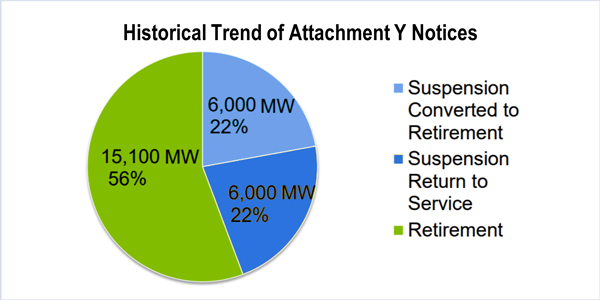By Amanda Durish Cook
MISO stakeholders are concerned over the RTO’s unit retirement proposal, saying it could result in conflicts over interconnection service rights between suspended units and those in the queue.
“Folks were not comfortable with granting … conflicting interconnection rights,” MISO engineer Patrick Jehring said during an April 17 Planning Subcommittee meeting.
MISO is proposing to model suspended units as offline during the three years of their suspension, then considering them available to participate in local balancing authority dispatch in planning scenarios thereafter. Units that retire during the three-year process by waiving their interconnection rights with MISO will be modeled offline indefinitely in planning models.
Jehring said the modeling plan is like the three-year offline modeling used today but aligns with MISO’s new proposal to have generation owners considering a shutdown enter a catch-all suspension period for three planning years.
Owners would no longer have to decide between a permanent retirement and a temporary shutdown, which requires an estimated return-to-service date. Instead, they would have three full planning years to prepare a return to service or decide on retirement. Suspended generators would lose interconnection service after three planning years if they don’t resume operations. (See MISO Readies Retirement Change.)
Pat Hayes, LS Power transmission policy manager, asked what happens when the owner of a suspended unit returns after the three-year rescission period to find that new generation is poised to assume its interconnection service.
“It’s never happened before,” Jehring said. In such a case, he said, the projects’ local transmission pricing zone would bear the cost risks of the network upgrades necessary to accommodate both the new and existing unit.
“Basically, the stars need to align for this situation to occur. … The likelihood of this occurring is low based on what we’ve seen in the past and what we expect in the future,” Jehring stressed.
Some stakeholders said MISO’s modeling still leaves open the risk that local transmission pricing zones will bear the cost of interconnecting two conflicting units.
“I guess what I would say to that is the possibility for this rift already occurs today. It’s an if-upon-if-upon-if situation to get to that situation,” Jehring said.
Of the approximate 27 GW of Attachment Y suspension/retirement notices that MISO has received, Jehring said only 6 GW has returned to service. MISO unit owners typically submit Attachment Y when catastrophic equipment failure occurs or the units become uneconomic to operate. “When we think about the magnitude of it, we’re only talking 6,000 MW.”
Jehring said including suspended units in the dispatch in modeling after their three-year suspension period doesn’t mean the units would ever be dispatched again. The decision to dispatch is based on the “most economic firm resources being utilized to meet a local balancing area’s firm load and interchange obligations,” according to MISO.
“If a unit goes on suspension for economic reasons, it is unlikely it would be dispatched in the planning models anyway,” Jehring said. “The only real reason that a unit will stay on suspension is they’re on the economic bubble … and they’re truly seeing if they’ll become economic again.”
MISO will accept written stakeholder comments on the modeling proposal through May 4.





